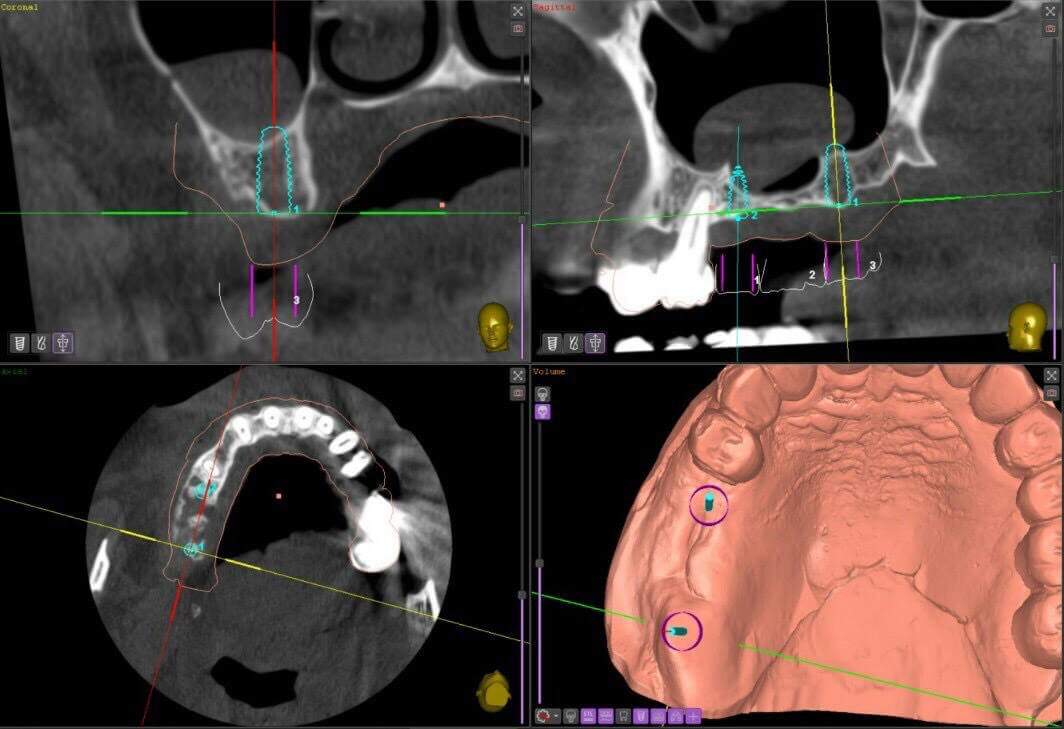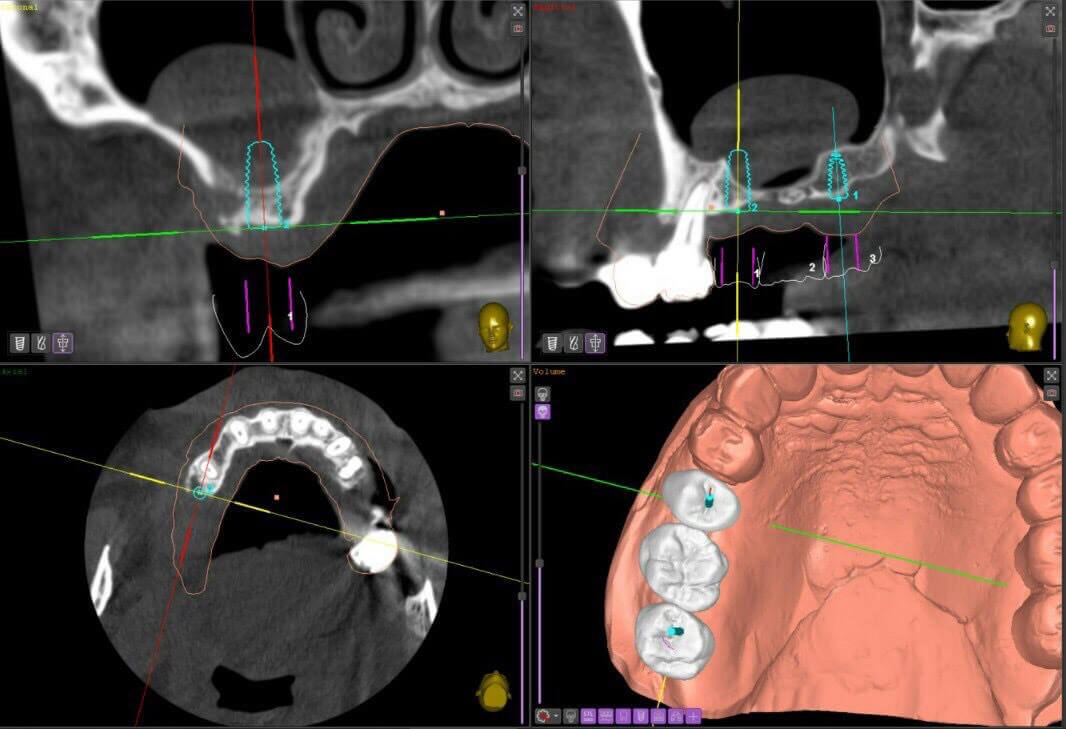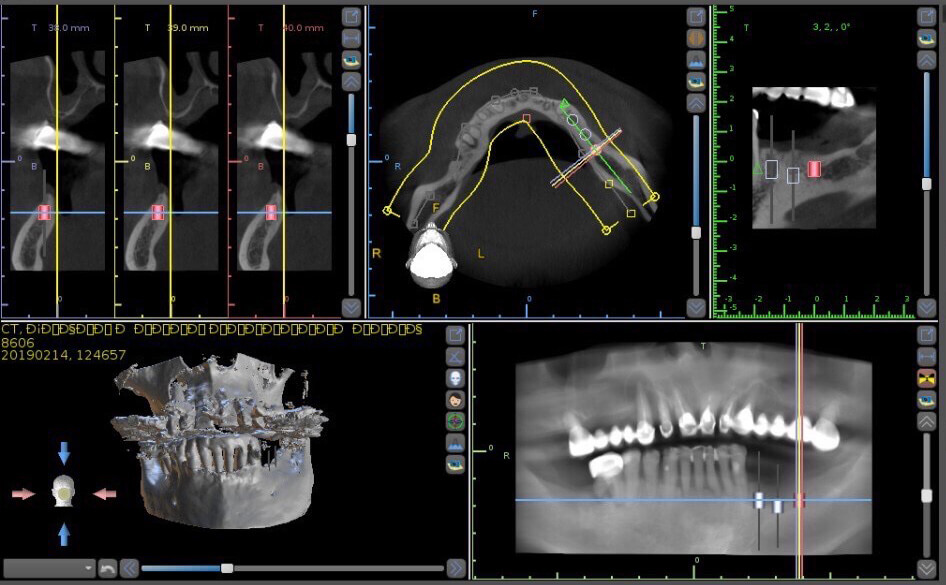Quality dental implant surgery is a properly performed surgical procedure that includes planning for future prosthetics.
When a person visits a dental clinic to get a dental implant, the surgeon does not place implants – he/she builds a foundation for future prosthetics.
The main goal is to get teeth, not just implants.
Preparation for Dental Implant Surgery
First, we must carefully engineer a prosthetic solution. For this purpose, proper diagnostic testing is conducted. It is performed by a dental surgeon and a prosthodontist, who examine a computerized tomography (CT) scan of the jaw and the area where implants will be placed. The same scan is also used to plan the position of the future orthopedic structure. Also, a CT scan and X-ray are used to analyze the bone quality to understand what implant type we can use. The CT scan helps us learn the height and width of the bone, so we can make a 3D model of the implant. This is the main examination performed before the surgery.
Also, the diagnostic procedure implies interviewing and examining the patient. During the examination, we find out whether the patient has chronic inflammatory processes or periodontitis and determine the hygiene index.
In terms of surgical preparation, we check whether the patient is ready for surgery, conduct preliminary blood tests, study the medical history, talk to the patient, and collect information about their medical conditions.
Based on the information obtained, we plan the surgical stage.


We can start preparing the patient for dental surgery upon receiving the information from the CT scan, laboratory tests, and the prosthodontist’s report. Successful surgery is impossible without these data.
During the preparation phase, we inform the patient that the implant placement procedure is surgery. And surgery has its laws and risks, all of which we outline and discuss. Much depends on the bone quality, the medical condition, the number of lost teeth, the bite, and other factors.
Of course, when planning the dental implant procedure, we take into account the bone quality and anatomical and physiological aspects of every patient.
If there is bone loss, it will be necessary to perform bone grafting before implantation. Some anatomical formations must be taken into account during the implant placement to avoid interfering with the anatomy of the lower or upper jaw. The implant must be placed correctly so that the prosthodontist can properly place a crown or dental bridge on it.
To avoid possible health complications, we must first assess the medical condition of the patient. If additional treatment is needed before implantation, we must provide it. A well-prepared patient is a cornerstone of a successfully performed surgery without any undesirable effects.
Bone Grafting
If the bone volume is insufficient, we can offer bone grafting – surgery aimed to increase the bone volume, its height or width in the area where we place the implant.
We resort to bone grafting only when necessary and in case of strong medical grounds. In most cases, modern technology makes it possible to avoid bone grafting. This surgery makes the rehabilitation process longer and more complicated. But if necessary, we conduct such surgical procedures of any complexity for our patients.
Bone grafting can be performed under sedation or anesthesia, but most often, bone grafting surgery and even complex dental implant surgery are performed with local anesthesia. It is easier and simpler to work with patients when they are conscious and can respond to requests. At the same time, the patient feels no pain or discomfort during the surgery.
Selection of Implants
During consultations, oral surgeons rarely say that “this implant will serve for 5-10 years” – they tend to promise that it will serve “forever.” They don’t mention that any implant has a lifespan. Implants vary in design, which affects their service life. An implant may be integrated into the bone, and you may not lose it in a year or two, but bone resorption can occur. In such a case, half of the implant remains placed firmly in the bone, while another half sticks out from under the gum surface.
We offer implants that will last for years. By using implants from manufacturers that have been clinically testing and proving their products for 35 years, we can be confident that we’re making the right choice.
Surgery Planning
3D planning is available and widespread today. A 3D teeth model is created on the computer, and implants are placed in the right position on this model. Special templates are used to place implants correctly as indicated on the 3D model. We must note that the use of the template is not always necessary, and it is produced at the surgeon’s discretion and based on his or her expertise.

Stages of Implant Healing
The implant must be initially stabilized and must stay immobile once placed in the bone. The placement of the implant must be done without bone compression, overpressure, or overtightening. The implant must be fully embedded in the jaw bone.
These are two important criteria that allow us to think that dental implant surgery is done successfully.
Postoperative Period
We can confidently say that the surgery was successful 3 to 5 days after the procedure. We should also mention that the positive outcome of implant surgery is greatly affected by the way the patient follows the doctor’s prescriptions in the postoperative period.
The implant is integrated into the bone in such a way that the hole where the implant was placed heals, and a healthy bone forms around the implant. If the implant remains immobile, it means it has integrated into the bone.
This process involves two stages:
- Primary stabilization, once the implant is placed firmly in the bone.
- Secondary integration, when the bone heals, and the implant remains immobile 21 days after the surgery, causing no pain. If an X-ray shows no signs of inflammation, we can say that the implant was placed successfully.
Why Quality Dental Implant Surgery Cannot Be Cheap
High-quality dental implant surgery must be performed in a properly prepared clinical environment. The clinic must have a fully equipped surgical suite, appropriate office ergonomics, special lighting, and irrigation systems. The surgical area must be equipped with shadow-free lamps.
A regular dental room is usually much smaller than a surgery room, and it is difficult to accommodate all the necessary equipment, an anesthesiologist, a first assistant, a second assistant, and a surgeon in it. Such settings require significant financial resources.


